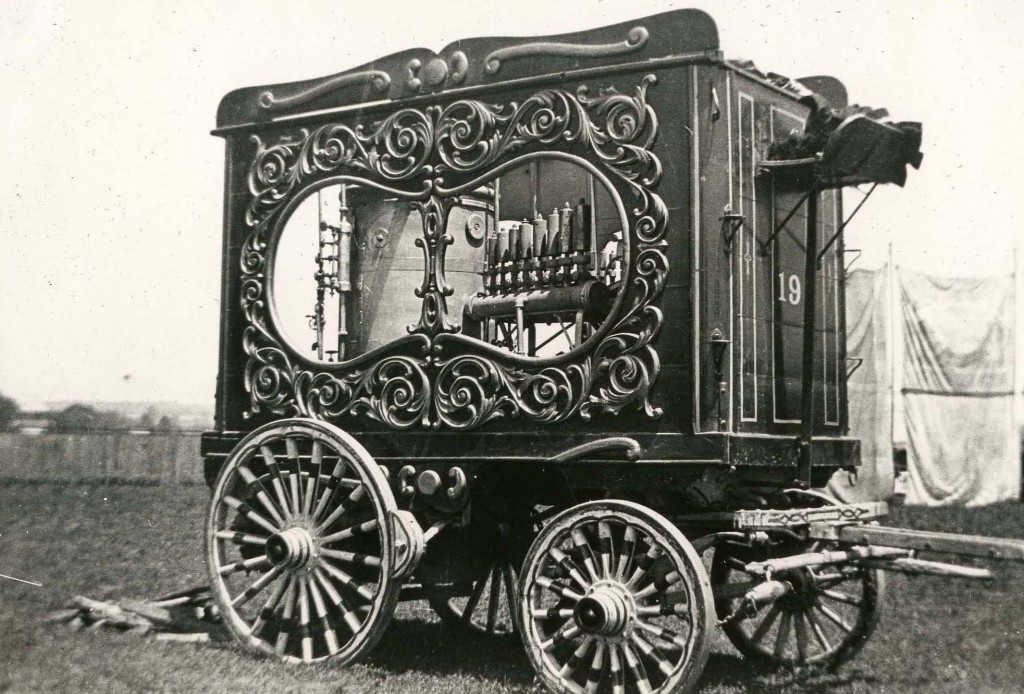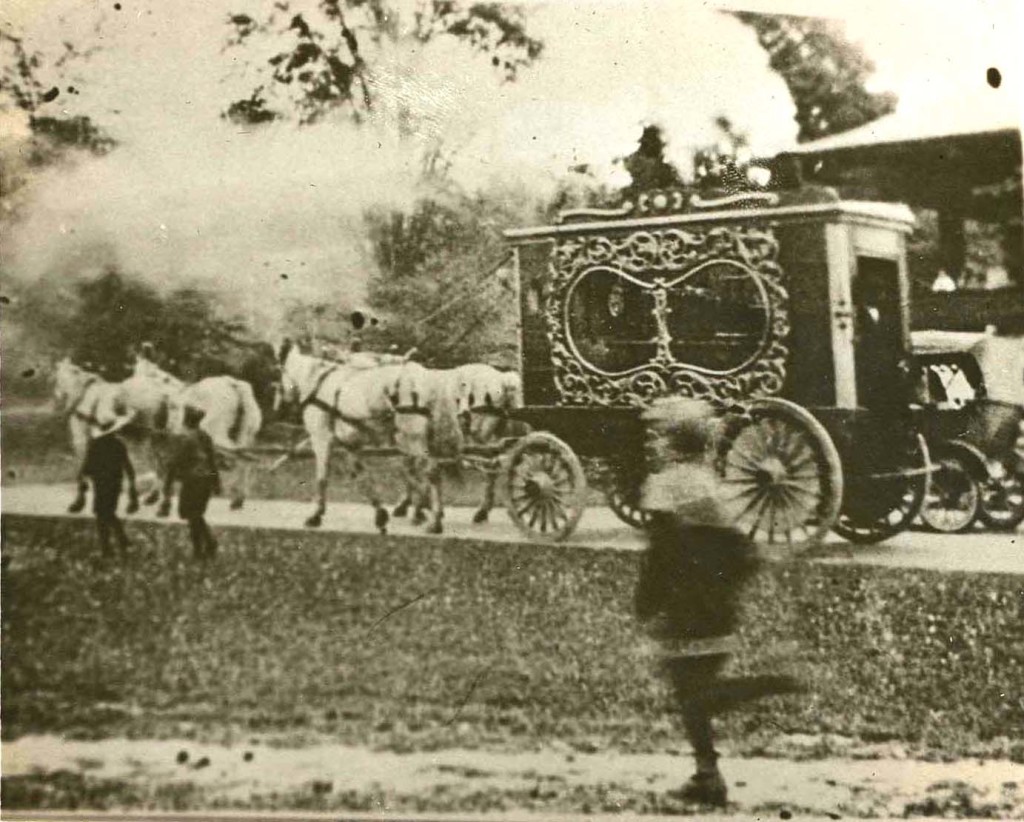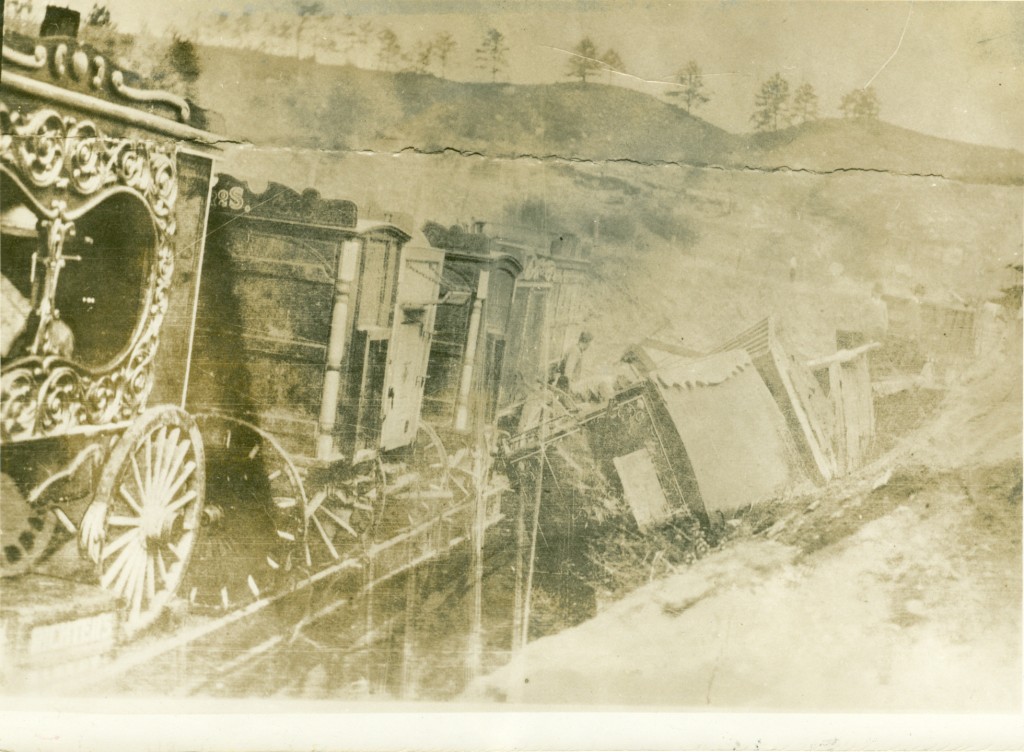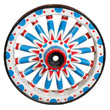Howe’s Great London Shows Steam Calliope
by Joseph Bradbury
(1) This wagon goes way back into early Jerry Mugivan and Bert Bowers days. I have a photo showing it on their Great Van Amburgh Shows in 1907, and possibly it dates back to 1904, the year that Mugivan and Bowers put their first circus on the road under the title of Great Van Amburgh. I have no idea who built the wagon or where Mugivan and Bowers got it.

( 1907-1909 – Joseph Bradbury Album # 18 – photo # 69A – Howe’s Great London Shows Steam calliope – W. Hope Tilley photo )
In 1908 they changed the name of their show to Howes Great London Shows and continued operation of that title through the 1916 season. It can be assumed the calliope remained on the show, although it is entirely possible it may have been switched over to Mugivan and Bowers second show which they put on the road for the 1911 season under title of Sanger’s Greater European Shows. This show used the equipment of the Dode Fisk Shows which Mugivan and Bowers purchased during the winter of 1910-11. The Sanger title was used also in 1912 and 1913, although Mugivan once said in an interview that they switched to the title of Robinson’s Famous Shows during the 1913 season. They had purchased that show from Danny Robinson in 1912. However, most historians believe the title of Robinson’s Famous wasn’t used until 1914, although it is entirely possible that a change of name did occur during mid-season 1913. Robinson’s Famous Shows title was used on the second show for 1914, 1915, and 1916 became known as the John Robinson Circus, the title having been purchased from John G. Robinson in early 1916.
(2) At some point in time between 1907 and 1919, this wagon was extensively refurbished. The painted wheels were replaced or modified to have the sunburst patters added. The wagon body was extended outwards at the front and the back ends around a foot in length. The bed of the wagon appears to be about 4″ think which was then adorned with a single scroll carving in the 1907 photo. That carving and those on the mudboards all were removed by 1919.
The Howes show did not go out in 1917, 1918 or 1919, however, in 1917 some Howe equipment was used to enlarge the John Robinson show. The steam calliope is believed to have been stored from 1917 until 1920, when Mugivan and Bowers again put the Howes Great London Show on the road for the 1920 season with Danny Odom as manager. The show that season traveled on 15 cars, with 1 advance, 4 stocks, 6 flats, and 4 coaches.

( 1920 – Conover Set # 113 – photo # 1 )
In the winter of 1920-21 the calliope was sold to Palmer Bros. Big 3 Ring Wild Animal Circus, a new show being framed by W. F. “Doc” Palmer, John T. Bachman, and Al Tinsch. The new show went out in 1921, experiencing a train wreck during the season where another partial photograph of the wagon was taken.

( 1921 – loose 5″ x 7″ negative in the Conover Photographic collection )
At the end of the season, the show was sold to a group composed of Mike Golden, Milt Runkle and Chas. J. Adams, who had leased the Howes Great London title from Mugivan and Bowers. They put the show out for the 1922 season on 15 cars, with 1 advertising, 3 stocks, 7 flats, and 4 coaches. In 1923 and 1924 the show was called Golden Bros. Circus with Mike Golden at the helm until he sold the show in mid-season 1924 to John Pluto, who in turn sold it to G. W. Christy a couple months later.
Christy renamed the show Lee Bros. Circus and put it out, still on 15 cars, for the 1925 and 1926 seasons. Sometime after 1925 Christy had a new wagon built to house the calliope, but just when this occurred it is not known to this scribe. Some have reported that the old wagon was still on the Lee Show in 1925 but I have not been able to determine definitely if the old wagon was still in use in 1926. Lee Bros. was taken off the road following the 1926 season and for years after, G. W. Christy advertised in the Billboard a 15 car circus for sale, which he did finally sell to Ken Maynard in 1936. When the property arrived in California the new wagon to house the calliope had been completed, but just when it was built for sure I still can’t say.
(1) Bandwagon, Vol. 3, No. 1 (Jan-Feb), 1959, pp. 10-12
(2) Additional insight added here, not in the Bandwagon article
If you have any questions or have more photographic evidence, feel free to contact us at circuswagons@gmail.com
